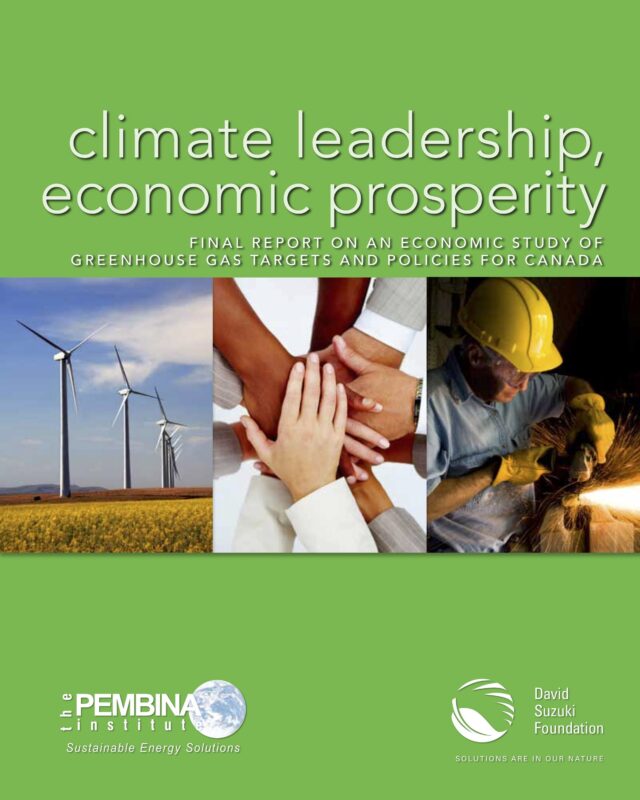Climate Leadership, Economic Prosperity: Final Report on an Economic Study of Greenhouse Gas Targets and Policies for Canada “
Published by:
David Suzuki Foundation and partners
Authored by:
Matthew Bramley,
Pierre Sadik,
Dale Marshall
Partners:
Pembina Institute
ISBN:
978-1-897375-28-0
Climate solutions decarbonization, greenhouse gas emissions, policy and regulation, Alberta, Saskatchewan, industry, energy, sustainable transportation, economics, climate change, renewable energy
Broad scientific consensus holds that more than 2 C of average global warming above the pre-industrial level would constitute a dangerous level of climate change. The science indicates that to avoid exceeding the 2 C limit, industrialized countries need to reduce their combined emissions of greenhouse gases to 25 to 40 per cent below the 1990 level by 2020.
The Government of Canada’s current GHG target of 20 per cent below the 2006 level by 2020 is a much more modest reduction of just three per cent relative to the 1990 level. However, as it is the government’s current commitment, it is important to understand what policies would be needed to achieve this target.
The Pembina Institute and the David Suzuki Foundation therefore commissioned an in-depth study of federal and provincial government policies that would allow Canada to meet a 2 C target to reduce GHG emissions to 25 per cent below the 1990 level by 2020, based on the science outlined above, as well as the federal government’s current target.
The analysis shows that with strong federal and provincial government policies, Canada can meet the 2 C emissions target in 2020 and still have a strong growing economy, a quality of life higher than Canadians enjoy today and continued steady job creation across the country. The analysis also shows that the federal government needs to implement far stronger policies than it has proposed to date to meet its current GHG target.
Key findings of the study include:
- Canada’s gross domestic product would continue to grow at 2.1 per cent per year on average between 2010 and 2020 while meeting the 2 C target, compared to 2.2 per cent for the government’s target and 2.4 per cent under business as usual.
- Canada’s total number of jobs would grow by 11 per cent between 2010 and 2020 while meeting either target—essentially the same rate as under business as usual.
- The urgent need to address very high emissions in Alberta and Saskatchewan would significantly reduce projected growth rates in these provinces. However, Alberta’s per capita GDP would continue to be much higher than that of any other region, and Saskatchewan’s per capita GDP would stay close to the Canadian average.
- To meet the 2 C target, a carbon price would start at $50 per tonne in 2010 and reach $200 per tonne by 2020. To meet the government’s target, the carbon price would need to reach $100 per tonne by 2020, or $145 per tonne if Canada does not purchase any international credits.
- Almost half of carbon price revenue can be returned to Canadians through reductions in income tax. Revenue from carbon pricing can also fund major public investments to reduce greenhouse gas emissions, such as building smart grids and transit infrastructure.
- Technological approaches to achieve major reductions in Canada’s greenhouse gas emissions range from increased energy efficiency and renewable energy to carbon capture and storage.
